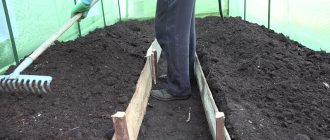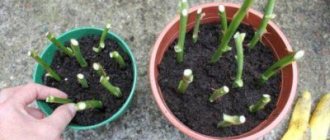A bouquet of roses is a romantic gift, which is most often presented by men to the fair sex. Of course, such a sign of attention improves your mood, but from a practical point of view, the gift is short-lived. However, experienced flower growers know that the life of flowers can be extended for more than one year by rooting their cuttings and planting them in a garden or pot.
Rose is a capricious plant. The more exotic the color of the bud, the more difficult it is to work with the flower. Despite this, it is possible to plant almost any material. How to root a rose from a bouquet at home and how to care for it afterwards, read our article.
Which roses from a bouquet can be rooted
It is possible to propagate roses from a purchased bouquet. Flower stems are rooted at home and then grown in an apartment or garden . Such a plant will remind you of the person who gave the flowers for many years.
How easy it is to grow a rose from a cutting depends on the shade and origin of the flowers. You need to pay attention to the following parameters :
- Color . Red, white, pink and cream roses take root easily - in 80% of cases. Instances of yellow, blue, purple shades, as well as multi-colored ones, throw out roots much worse, but their rooting is also possible.
- Domestic varieties . Rooting of flowers grown in our country occurs faster, since they are more hardy and are often grown without a lot of chemicals. Dutch and other foreign roses grown on an industrial scale are more difficult to propagate. This is due to the use of a large number of growth stimulants and fertilizers. Such roses adapt less well to home conditions.
- Freshness of the bouquet . The longer flowers stand in water, the worse they take root. It is recommended to prepare cuttings immediately after delivering the bouquet home.
- Appearance of buds . If the flowers show signs of infection with diseases and pests (aphids, spots, holes, etc.), they will have to be abandoned. Such seedlings will not survive subsequent cultivation, will become sick and can infect other plants.
If the bouquet does not fit into the specified parameters, this does not mean that the flowers cannot be rooted . It’s just that the chances that the cuttings will throw out roots and take root are lower.
Note! Some gardeners prefer to use stems from which the petals have already begun to fall off.
Selection and preparation of cuttings
Before cuttings you need to select suitable plants:
- Presence of kidneys . The axillary buds should not be dry and fall off when touched lightly.
- Degree of lignification of cuttings . Completely lignified cuttings with brown stems, as well as green, overly flexible stems, are not suitable. Most likely, they will not throw out their roots, but will rot. For germination, cuttings that are still green but already partially lignified are chosen (these are the stems usually found in roses in a bouquet).
- Stems thickness . The optimal thickness of the handle is equal to the diameter of a standard pencil.
- Appearance . The stems should not have cracks, spots or holes.
It is advisable that the cuttings have 2-3 leaves . In their absence, rooting is also possible, but it will occur more slowly.
- Use the top or central part . You will need a cutting about 15 cm long. It should contain 3-4 living axillary buds. The lower cut is made at an angle of 45° 1 cm below the bud, and the upper cut is made even 1 cm above the bud.
- The bottom leaf is torn off , leaving only the petiole. The top 2 are shortened by ½. No more than 3 sheets are left on the planting material, the rest are torn off. Remove all thorns.
- in a light pink solution of potassium permanganate for 2 hours
The lower part of the stem is not used , since with prolonged exposure to water it darkens, cracks and swells.
Advice. Some gardeners prefer to seal the lower cut of the planting material with paraffin.
Planting rose cuttings in autumn
Everyone knows perfectly well that rooted plants need to be planted in open ground in the spring and summer. It happens that harvested cuttings appeared long before the favorable planting time. How to preserve a rooted plant until the appointed time?
Cuttings are prepared for storage. All shoots from the cuttings are removed and treated with a growth inhibitor.
To treat the cuttings, use paraffin; this is a good way to slow down the growth of shoots. Paraffin is melted in a water bath, the upper part of the cutting is dipped and immediately immersed in water. This procedure can be repeated several times. Two or three layers of paraffin will reliably preserve the plant.
- The simplest and most relevant way to store cuttings is by digging them in open ground. This method is suitable for regions with mild climates. The cuttings can easily withstand a slight drop in temperature to 4-5 degrees. A trench is dug on the site, the dimensions depend on the amount of planting material, about 25 cm deep. The bottom is lined with straw or agrospan. We place the prepared cuttings on the insulation and cover the top with a layer of straw or insulation. Only now can you start filling it with earth. Leave small gaps between the cuttings; a tight fit can cause damage to the cutting.
- The basement and cellar will do an excellent job of preserving cuttings until spring. The cuttings are treated with paraffin and tied in several pieces. They are placed in boxes with sand and carefully covered with it. Good and long-term storage is guaranteed if the temperature is maintained at a cool temperature.
- If there is no cellar or basement, you can put the prepared cuttings for long-term storage in the refrigerator. The upper part of the cuttings must be treated with paraffin. The lower sections need to be provided with a constant moist environment. Use moss as a nutrient substrate. Cuttings of the cuttings are wrapped in damp moss and all this is neatly placed in a plastic bag. The bottom shelf of the refrigerator maintains the required cool temperature. Moss dries out over time, so you need to occasionally take out the bag and moisten it.
- Once you decide on a planting location, start preparing the soil.
- The ground for planting must be carefully dug up and stones and debris removed from it.
- Ash and eggshells are perfect as fertilizer.
- A shallow planting hole is dug, depending on the size of the root system.
- The excavated soil is mixed with ash and eggshells.
- The cutting is lowered into the hole and gradually covered with soil from different sides.
- The plant is watered and the soil around the bush is slightly loosened to create oxygen access to the root system.
- By following the correct planting technology, you can soon see the appearance of young shoots.
Autumn planting of rose cuttings from a bouquet is possible provided the winter climate is mild. Favorable time for planting is October, but no later than November 10-15.
- Prepare the cuttings and dip the lower cut into the root compound.
- The planting hole should not be more than 30 cm in diameter; if desired, planting can be done in trenches.
- Cuttings should be planted at a cutting angle; one or two buds may remain above the surface.
- The plant is watered and mulched with straw.
- To prevent freezing, cover the cuttings with jars or cut plastic bottles. The jars may be cracked or damaged. Several cuts must be made in the plastic. Air circulation is necessary for plant development.
- Cans and bottles are covered with insulation or covered with a thick layer of straw.
In other regions, rose cuttings can be planted in pots in the fall.
You can use one large container to plant several cuttings.
- To ensure greater safety in winter, the upper part of the cutting is treated with paraffin.
- Cover the bottom of the slide with a small layer of drainage made of expanded clay or broken ceramic dishes.
- You can use a ready-made soil mixture as soil, or take garden soil and mix it with perlite.
- The soil for planting should be slightly moist. Prepare holes for cuttings.
- The cuttings are dipped in the growth stimulator with the lower cut and placed 4-5 cm into the soil holes.
- The container must be wrapped in film or wrapped in cellophane. Wrap in a blanket or insulation and place in a cool place.
Avoid sudden drops in temperature as this can kill the plants.
Knowing all the subtleties and nuances of planting, you can safely start growing roses from a bouquet, regardless of the time of year and weather conditions. Don't be afraid to experiment, follow these tips and grow lush, stunning rose gardens.
Suitable timing
When growing roses from a bouquet, it is important to consider the timing of planting. It depends on them whether the cutting will take root .
Timing for planting roses from a bouquet:
- Summer . This is the best time to plant roses from a vase. The probability that the cutting will produce roots is 90%.
- Autumn . The first half of autumn is also suitable for growing roses from a bouquet. The probability of their rooting reaches 80%. In late autumn, when daylight hours become short, this probability drops to 50%.
- Spring . In spring, roses take root in 60-70% of cases. The closer to summer, the higher the chances that the plant will take root.
- Winter . In winter, the chances of successfully growing a flower from a bouquet are much lower. They reach 30%, but increase in the presence of artificial lighting.
Interesting things on the site:
How to grow tulips by March 8
Growing tulips in a pot at home
Rooting methods
Pink shoots are planted using different methods . Some of them are truly unusual. The chances of rooting are approximately the same in all cases.
In water
Rooting stems in water is the most popular way to propagate purchased flowers from a bouquet . It requires a minimum of materials and time from the grower. Its disadvantage is that the stems sometimes rot in water. This is avoided with the help of special additives to the liquid.
Step-by-step instructions for planting rose cuttings in water:
- Pour 3-4 cm of liquid into the bottom of the container. To prevent rotting of the stems, add a little potassium permanganate (you should get a light pink solution), Glyokladin (according to the instructions) or Fitosporin (according to the instructions).
- Cover the container with the cutting with the top of a plastic bottle or bag and put it in a cool, bright place.
- Every day, the cuttings are ventilated for 15 minutes by removing the bag or unscrewing the cap at the top of the bottle. The stem is sprayed with settled water at room temperature.
- The water is changed every 2 days. It is not necessary to add disinfectants every time.
After 2 weeks, roots will begin to form . After this, the sprout is planted in the ground.
In the ground
You can also propagate roses from a bouquet in the ground. Before this, the bouquet must stand in water for 24 hours .
The soil is used purchased (special for roses and other flower plants) or prepared independently from equal parts of garden soil, sand and peat. The soil must be disinfected with a dark pink solution of potassium permanganate or calcined in the oven.
How to propagate a rose in the ground:
- The container is filled with soil and drainage. “Glyokladin” or “Fitosporin” is placed on the bottom. The soil is watered abundantly.
- The lower cut of the cutting is dipped into dry “Solution” or “Kornevin”. Then they stick it into the ground so that it stands without support.
- The top of the cutting is covered with a bag or a cut bottle. Every day the shoot is ventilated for 15 minutes.
- The seedling is placed on a southern windowsill and grown at room temperature. As the top layer of soil dries, the rose is watered with warm, settled water.
The formation of leaves and shoots indicates that the seedlings have taken root . After this, the duration of ventilation begins to increase. Then the greenhouse is dismantled.
Note! It is important to ensure that the water does not stagnate, otherwise the stems will rot. There should be holes in the bottom of the containers. It is also important to use drainage.
In potatoes
One of the most unusual ways to grow roses is rooting them in potatoes. Its advantage is that the raw root vegetable contains a sufficient amount of moisture, as well as nutrients necessary for rooting of the cutting.
How to plant a rose in potatoes:
- Large potatoes are washed from the soil. They check that there are no traces of diseases and pests on it. All eyes are removed.
- Use a knife to make a small hole in the root vegetable. The cutting is stuck into it with the pointed part.
- The potatoes are placed in a deep container and covered with soil so that one pink bud is underground.
- Water the soil with warm sweet water (2 teaspoons of sugar per 1 cup of water). Then the containers with the cuttings are covered with film or a bag.
- Every day, the seedlings are ventilated for 15 minutes and sprayed with warm water from a spray bottle. Once every 5 days the soil is moistened.
When leaves and shoots begin to form on the rose, the duration of ventilation is increased . Then the greenhouse is removed and the plant is transplanted into the ground.
In the package
It is possible to germinate pink stems using only a bag and newspapers. This is another interesting way to propagate flowers from a bouquet :
- At the bottom of a large plastic bag, lay several layers of newspaper torn into pieces. Some gardeners prefer to use crumpled whole sheets.
- The newspaper is filled with water with the addition of “Fitosporin” and left until the liquid is absorbed. The inside of the bag is sprayed with water from a spray bottle.
- Prepared cuttings are dipped cut side into a dry root formation stimulator (“Kornevin”) and placed in newspaper.
- The bag is tied at the top and leaned against a support. This method is convenient for germinating a large number of cuttings.
- As the newspaper dries, moisten it with warm, sweet water. It is not the rose that is sprayed from the spray bottle, but the inside of the bag.
- The package is opened daily for 15 minutes for ventilation.
When the roots appear, the rose is transplanted into the ground.
Advice. Flower growers recommend taking several pink cuttings and growing them in different ways.
Optimal conditions for rooting cuttings
For rooting to be successful, you must try to create the most favorable conditions for the cuttings. There are not many requirements. Here are the three main ones:
- The optimal temperature is within + 25º. I think everything is clear with this point.
- Humidity 80 - 90%. Humidity is determined quite simply. Rose cuttings are grown under film cover or under jars; if the film is foggy from the inside, then the humidity is normal; if it is dry, it’s time to water.
- Neutral, poor soil. The easiest option when growing roses in open ground is to mix soil with sand in a 1:1 ratio. Just don’t try to add manure or compost. These adult roses love manure fertilizers, and cuttings from such additives can rot. In winter, cuttings can be carried out in peat, in peat mixed with sand, in perlite, vermiculite (vermiculite is preferable), in coconut fiber, or, as in summer, in soil with sand. In addition, you can use sphagnum moss.
You've probably heard other tips and tricks that should have a positive impact on the outcome of your case, but in practice, most of them either have minimal impact or are completely useless. I mean the following tips:
“You need to cut the leaves by half or 1/3.” This action does not affect the germination of roots in any way, you can cut it, you can leave it whole. The only thing you need to know and follow is that when cuttings in the light, leaves are needed, and when germinating in the dark (for example, using the buritto method), the leaves need to be cut off. Sometimes I cut plants in an aquarium and shorten the leaves there so that they don’t puff up, but this is only to save space.
It is convenient to carry out cuttings in an old aquarium.
“Use Kornevin or some other root-forming preparation” I repeatedly conducted unplanned experiments, dusted one batch of cuttings with Kornevin, and simply forgot to do it on the other. Thus, I had the opportunity to make sure that these preparations do not have any noticeable, positive effect on growing roses from cuttings (may the manufacturers of these powders forgive me).
“Deep the cutting into the ground 1 - 1.5 cm.” In my opinion, shoots buried 5 - 7 cm take root, if not better, then at least no worse, but working with them is much easier. Chibouks stuck 1 cm into the ground fall off with the lightest touch
Especially if their spines are not cut, which tend to get caught on everything.
“Make the lower cut at an angle of 45º, and the upper one at an angle of 90º.” Make the lower cut immediately under the bud, always with a sharp tool, and at what angle it will be made is absolutely not important. It is recommended to make the lower cut at an angle of 45º to increase the cutting area
It is at this place that callus then forms, and people probably think that the larger the area of the callus, the more roots it will grow. The most important thing is that the callus simply forms, and the roots will grow, you can be sure
It is recommended to make the lower cut at an angle of 45º to increase the cutting area. It is at this place that callus then forms, and people probably think that the larger the area of the callus, the more roots it will grow. The most important thing is that the callus simply forms, and the roots will grow, you can be sure.
But to increase the number of roots, I can recommend a more effective method. Callus, and then roots, appear on the injured parts of the stem, so several small wounds can be made on the part of the shoot that will be in the ground.
I usually remove all the thorns on the cuttings. On the above-ground part I cut it off with pruning shears, and on the part that will be in the ground I break it down to the base and a wound is formed in this place. Roots almost always grow from these wounds.
Callus formed in place of the broken spines.
The photo, unfortunately, is not of high quality, but I think it is clear that in place of the broken thorn an impressive callus has formed, from which roots will soon appear. I grew these cuttings in perlite, so they are so clean and everything is clearly visible.
Now let's talk about the most important thing: how can we learn to grow roses from presented bouquets?
The thing is that bouquets of roses are given throughout the year. And cuttings of roses in summer and winter, for obvious reasons, are very different. Therefore, each option will have to be considered separately, that is, seasonally.
How to root a rose: step-by-step instructions
After roots appear on the cuttings, they are transplanted into a pot of soil. This is done as follows :
- A layer of drainage is poured onto the bottom of the pot with holes. The rest is generally filled with soil. It is watered with a light pink solution of potassium permanganate. After this, the soil is allowed to stand for a day.
- The rose is removed from the place where it was germinated and transferred to a pot. Bury 1 cm above the formed roots.
- The top of the seedling is covered with a plastic bag, glass jar or cut-off bottle. Ventilate for 15 minutes.
Grow roses at room temperature on a south-facing windowsill . The greenhouse is dismantled after the leaves appear, after hardening the plant, gradually increasing the ventilation time.
After the film is removed from the plant, it is continued to be sprayed with a spray bottle . In winter, a humidifier is installed in the room to create optimal humidity levels.
Fertilizing is applied once a month . Use special fertilizers for flowering plants or a mixture of superphosphate, potassium sulfate and ammonium nitrate.
Planting cuttings in the ground and caring for them
To successfully plant prepared cuttings, the main thing is to select the soil, provide the necessary microclimate and water correctly. One of the differences when rooting from a bouquet is due to the fact that it can be carried out not only in summer, but also in winter, although with less survival rate. In this case, future bushes, naturally, must be kept in a warm room, in boxes or flowerpots.
The soil should be loose, contain enough air and retain moisture well. A slightly alkaline soil reaction is allowed, but neutral is best. Acidic soil is not suitable for roses. Pure coarse sand works well, but it is advisable to enrich it with nutrients by mixing it with garden soil, peat, and sawdust. Special soil for roses can be purchased at the store, especially if the future bushes are intended not for a flower bed, but for a flowerpot. You can root cuttings in boxes, providing a drainage layer under the soil.
Cuttings planted in the soil must be covered to create a mini-greenhouse for them with a certain microclimate - a temperature of 20 - 26 ° C and a humidity of 85 - 90%. In order not to deprive the cuttings of sunlight (after all, it’s not for nothing that we left them two green leaves for photosynthesis), use glass jars or cut-off plastic bottles, or set up a greenhouse under a film. The bottle can be cut off at the bottom and placed with the neck up so that you can water through it. If there is no shelter, water is poured from outside, trying to maintain consistently moderate soil moisture. Accumulating moisture on the inner surface of the bottle indicates that watering is not required yet. Air humidity is provided by daily spraying.
It should be borne in mind that even with ideal care, the survival rate of cuttings cannot be one hundred percent; in the best case, 8 cuttings out of a dozen planted take root. Some cuttings, without forming roots, develop at the expense of nutritional reserves. At first, they appear to be quite prosperous, but then they suddenly stop developing and die. This is the natural order of things, depending on the varietal characteristics; you should not be upset and expect more.
With the start of shoot growth from the upper bud, about a month after planting, the plant begins to be hardened, accustoming it to the open air. The greenhouse is opened slightly for a few minutes every day, increasing the duration of the procedure every day.
With proper care of the cuttings, in 2 months or a little earlier they will form roots. Buds may appear, but in the first, and even in the second, year this is harmful to the development of the plant, they need to be removed. In the third year after planting, the rose bush you grew from a bouquet is ready for full flowering.
What to do if the rose itself has given roots in a vase
It is also possible to work with a rose that has taken root on its own in a vase . When found, such a flower is separated from the main bouquet.
The root system is checked for the presence of rotting shoots . Then cut off the bud and remove excess leaves, leaving 3-4 leaves, cut to half. If the stem is long, it is cut so that about 5 axillary buds remain, in order to allow energy to be spent on strengthening the roots rather than maintaining green mass.
A flower with roots is planted in the ground . The soil is watered with a root formation stimulator. The seedling is sprayed with water with the addition of Epin.
When to replant in the ground
The seedlings are transplanted into the ground the next year after rooting . For planting, choose a warm time (April or May depending on the region). Before work, the plant is hardened by taking it outside and gradually increasing the time it stays there to a day.
To plant roses, prepare an area in a well-lit place protected from the wind . It is dug up, cleared of weeds, mixed with 6 kg of humus, 30 g of superphosphate and 25 g of potassium sulfate per 1 sq. m. m.
Dig holes according to the size of the pot in which the rose was located . It is planted together with a lump of earth, without deepening the root collar. Then water with warm water. At first, the plantings are covered with film at night.
What to do if the cutting does not take root
It is not always possible to root roses from a bouquet at home. In most cases, this occurs due to improper preparation of cuttings or the use of varieties that do not produce roots well.
Note! Thick, fatty stems with a reddish tint take root the worst.
If the cutting does not take root, but rots, it is not worth germinating . Any methods will not give results. In this case, you will have to use new planting material.
Non-green cutting method - “burrito”
This method is useful if the roses from the bouquet are slightly wilted or damaged. The name “burrito” is conditional; in fact, the cuttings are wrapped in newspaper, which is why they resemble a twisted Mexican tortilla. Thanks to this method, you can prepare many seedlings and experiment with the amount of moisture.
Take the thickest cuttings 20-25 cm long, remove all leaves from them and treat them with fertilizer that accelerates the growth of the root system. Wrap the finished shoots in damp newspaper or moisten it with water later. Excess liquid should drain, the paper should remain moist, but not fall apart. After this, place the bundle in a plastic bag and leave it in a place where the temperature is constantly +18 degrees.
The contents of the “Burrito” should be inspected once a week to check the degree of development of the shoots. If necessary, moisten the newspaper, it should not be too dry. If any cutting begins to rot or rot, throw it away and replace the paper with new one. After 2-4 weeks, caplus appears in the damaged areas - growths, from which the plant root then develops. This is a sure sign that the roses can be transplanted into a flower pot, and in the spring - into the garden.
Use of stimulants
Growth stimulants significantly increase the likelihood of root formation on cuttings. The following products are usually used for roses :
- "Heteroauxin". To prepare a solution, take 50 mg of the drug per 1 liter of liquid.
- "Zircon". For 1 liter of water take 0.1 mg of the substance.
- "Kornevin". Dilute according to the instructions or dip a cut of the cutting into a dry preparation.
- Honey water. For 1 tbsp. take 1 tsp of water. honey
- Aloe juice. It is diluted with an equal amount of water.
The cuttings are soaked in a solution of a growth stimulator for a day . Then the seedlings are periodically watered with it.











